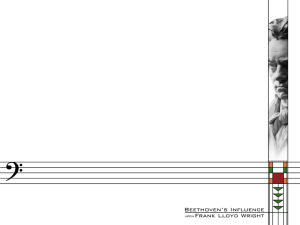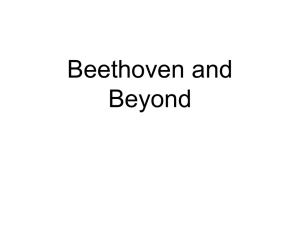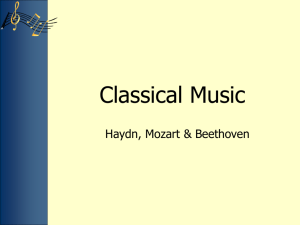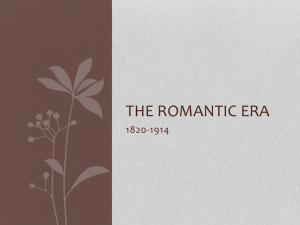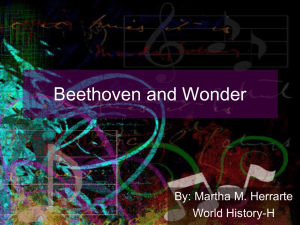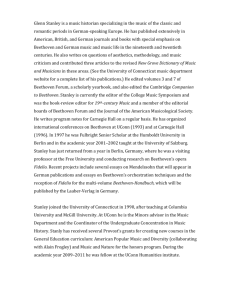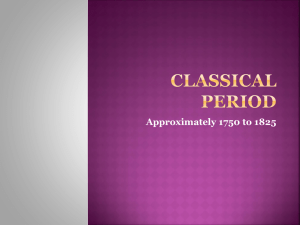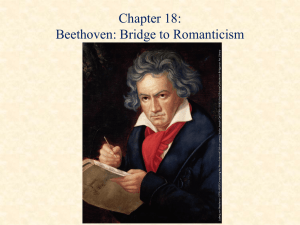Ludwig van Beethoven
advertisement
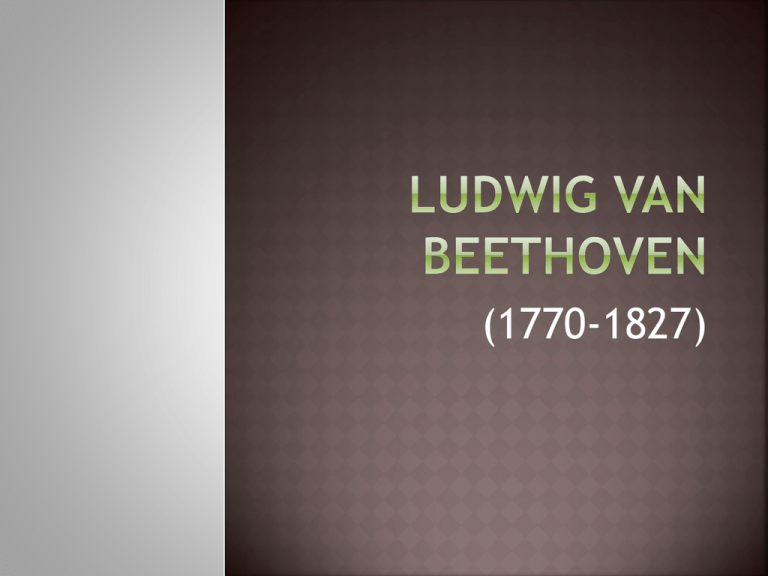
(1770-1827) Beethoven grew up when Haydn and Mozart were still actively composing; he studied the Classical style. He lived well into the 19th century when Romanticism was blossoming. He was a beneficiary of the change (from Classical to a Romantic style) and partly responsible for it. He took forms, procedures and ideas from the Classical period and developed them beyond their previously accepted limits. He enlarged the orchestra, changed musical structure, added a chorus to the symphony and told narratives with purely instrumental works. He was a child of one era and a father of the next. Born in 1770 into a family of musicians. Father and Grandfather were professional musicians at the court of the Elector of the German town of Bonn Father was an alcoholic, so as a teenager, Beethoven was put in charge of the family finances. He began a job at the court where he studied organ and composition and took care of the instruments. It was at this time that he began to compose songs and chamber works. In 1790, Franz Joseph Haydn passed through Bonn on his way to London. Beethoven and Haydn meet and Haydn agrees that upon his return to Vienna, Beethoven would study with him. In 1792, Beethoven moves to Vienna to study with Haydn, a great master. The lessons did not go well; Haydn was old fashioned and Beethoven was rebellious and headstrong. Beethoven was able to stay in Vienna and find work as a pianist. Prince Lichnowsky gave him room and board in return for piano music at parties and original compositions. Early, Beethoven mainly wrote keyboard and chamber-music pieces. As time passed, he decided to compose larger musical forms: string quartet, piano concerto and symphony At age 32, he had written piano sonatas, lots of chamber music, six string quartets, three piano concertos and two symphonies. Showing signs of individuality: 1st symphony deliberately begins in the wrong key, 3rd piano concerto features a unifying rhythm and the last movement of an early string quartet has a slow introduction (Melancholy) In 1802, Beethoven discovers that he is going deaf He contemplated suicide, but overcame this by deciding that his first responsibility was to produce the works that he had in his mind. In 1817, Beethoven could not hear a single note and communicated by means of an ear trumpet and a notebook slung around his neck. His deafness prevented him from performing or conducting, but he composed until the end of his life by hearing all of the notes in his head. Beethoven’s middle period included a focus on work with a sense of triumph over adversity. This period is often called the Heroic Period In one of his letters, Beethoven writes, “I will seize Fate by the throat”. He had extraordinary productivity in this period from 1802-1812 He composed six more symphonies, four concertos, five more string quartets, an opera, orchestral overtures, piano sonatas and chamber music. The music during this time is strong and confident with contrasting passages of great lyricism. They are also larger in scope (in the 3rd symphony, the first movement is longer than complete symphonies of Haydn and Mozart) Beethoven became popular during this period and his music was regarded as strong and patriotic (his homeland was at war with France) Family crisis: Beethoven’s brother dies and leaves Beethoven and his widow joint custody of his son, Karl This caused Beethoven great turmoil and distress. Having never married, he decided to seek sole legal custody of his nephew. He ultimately won his long, exhausting custody battle and his nephew came to live with him. His relationship with his nephew was stormy because Beethoven was strict and possessive. At age nineteen, Karl pawned his watch, bought two pistols and tried to kill himself. After this incident, Karl was allowed to return to his mother and he escaped Beethoven’s domination by joining the army. Beethoven gradually regains productivity His most important works of this period includes: the last three piano sonatas, the Ninth Symphony and a series of string quartets. Piano Sonatas are unusual in form and design, juxtapose complexity and simplicity Ninth Symphony, revolutionary in that it includes a choir and four vocal soloists. (The use of a choir in a symphony was unheard of at this time) The text for the last movement is a poem by Schiller: the Ode to Joy. Summation= “Let Joy bring everyone together: all men will be brothers; let all kneel before God.” Beethoven’s last three years were devoted to composing string quartets He died on March 26, 1827 at the age of 56 Stylistic traits include: 1. Long powerful crescendos that seem to carry the music inexorably forward 2. Themes that sound exactly right played quietly and very loud; 3. Dramatic use of Classic structures such as sonata form; 4. Sudden key changes that nonetheless fit into a powerful harmonic logic. During the latter part of Beethoven’s life, newspapers begin to emerge and print music reviews. As it is today, reviewers are not always fond of new music. Here are a few reviews of Beethoven’s music… On the Third Symphony, “It is infinitely too lengthy….If this symphony is not by some means abridged, it will soon fall into disuse.” On the Ninth Symphony, “crude, wild, and extraneous harmonies” “…ugly, in bad taste, cheap.” On all his music: “Beethoven always sounds to me like the upsetting of bags of nails, with here and there also a dropped hammer.”
